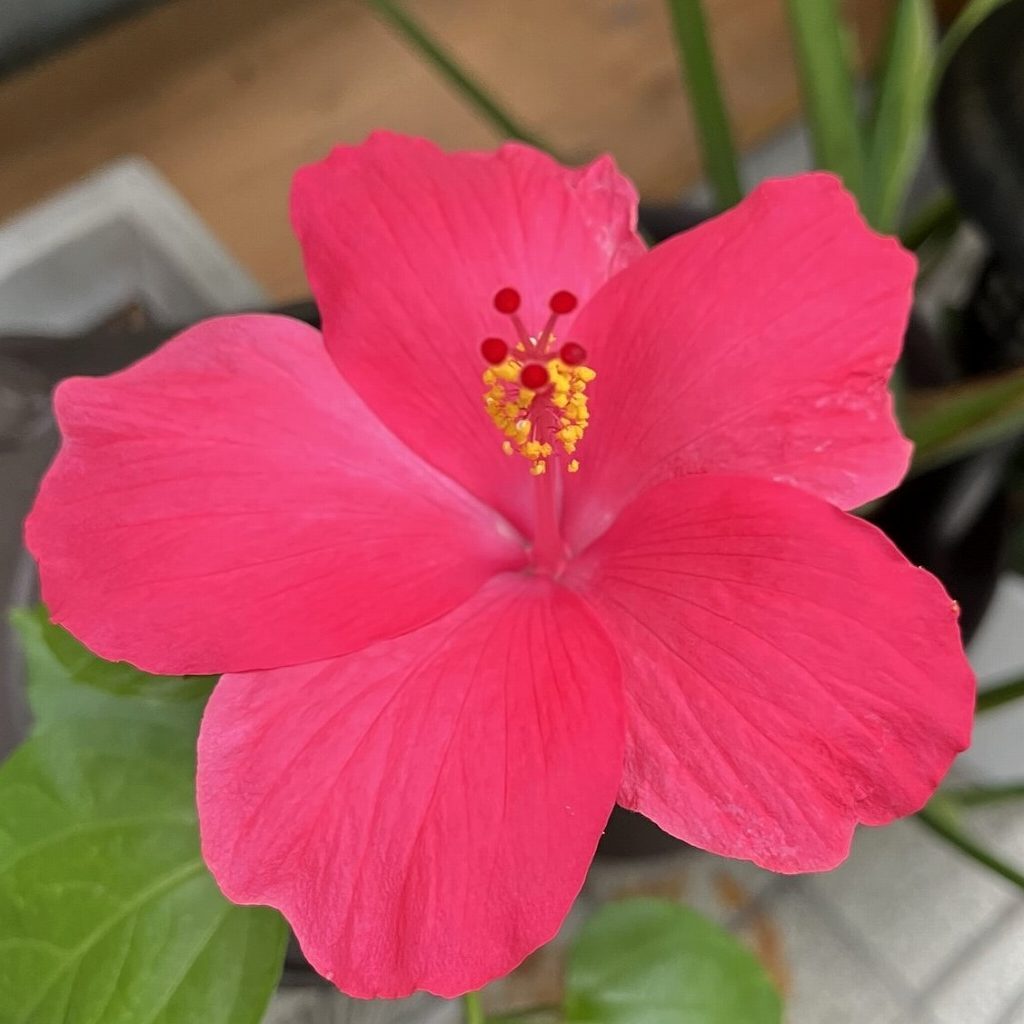ブッソウゲの園芸名「ハイビスカス」は本来フヨウ属全体の名称。沖縄では「後生花」とも呼ばれ、来世の安寧を願って墓所に植えられます。
Hibiscus, the horticultural name of Chinese Hibiscus in Japan, is originally the name of the entire Hibiscus genus. In Okinawa, they are also called “afterlife flower” and are planted at graves to pray for peace in the afterlife of the deceased.
【仮名】ブッソウゲ, ハイビスカス
【和名】仏桑花, 仏桑華
【英名】Chinese Hibiscus, Rose of China
【学名】Hibiscus rosa-sinensis
【誕生】07/ 11, 08/ 10, 09/ 22
【開花】07, 08, 09, 10月
【花色】White, Pink, Red, Yellow, Orange



ブッソウゲ
ブッソウゲの生態
ブッソウゲはアオイ科の常緑低木。多くの原種や交雑種が熱帯から亜熱帯にかけて分布し、日当たりと水はけのよいところで自生しています。日本では沖縄、九州南部、伊豆諸島南部、小笠原諸島などの暖地に、庭木や生垣で植栽。寒地や中間地では園芸種が温室で栽培されています。
ブッソウゲの名前
ブッソウゲの名前は中国で日本を意味する「扶桑」に花が添えられ、さらに「仏桑花」へ変化。沖縄では「後生花」とも呼ばれ、来世の安寧を願って墓所に植えられます。日本での園芸名「ハイビスカス」は本来フヨウ属全体の名称。種名はラテン語で「中国の薔薇」という意味です。
ブッソウゲの形態
ブッソウゲの葉は互生。幅広の卵形で先が尖り、縁に鋸歯が入り、表面に光沢があります。花は漏斗状で花弁が5枚、萼筒が5裂。雄しべと雌しべが合わさって真ん中から突き出ます。葯は黄色で多数、柱頭は赤色で5裂。咲いても、すぐに萎れる1日花ですが、次々と蕾が生じます。
ブッソウゲの種類
ブッソウゲの種類は3系統。例えば「ペインテッド・レディ」は花がやや小さいものの、夏でもよく咲く在来系です。「マドンナ」は暑さに弱いものの花が大きく、花色が目を引くハワイアン系。「スノー・フレーク」は暑さに強く、小ぶりの花々が垂れ下がって咲くコーラル系です。
ブッソウゲの近縁
ブッソウゲの近縁種「ローゼル」は赤紫色の茎にクリーム色の花が咲きます。そして、肥厚して赤く熟した萼と苞が生食のほか、ジャムやゼリー、果実酒や薬草茶などに加工。特にハイビスカス・ティーはクエン酸に富み、風味も爽やかで、風邪や咽頭痛、利尿などにも用いられます。
Chinese Hibiscus
Chinese Hibiscus is an evergreen shrub of the Malvaceae family. Many original species and hybrids are distributed from the tropics to the subtropics, growing naturally in sunny and well-drained. In Japan, it is planted as garden trees and hedges in warm areas such as Okinawa, southern Kyushu, southern Izu Islands, and Ogasawara Islands. In cold and intermediate regions, cultivars are grown in greenhouses.
The name of Chinese Hibiscus in Japan was “Fuso”, which means Japan in China, with a flower attached at first, and had been changed to “mulberry flower of buddha”. In Okinawa, they are also called “afterlife flower” and are planted in graves to pray for peace in the afterlife. The horticultural name “Hibiscus” in Japan is originally the name of the entire Hibiscus genus. The species name means “Chinese rose” in Latin.
Chinese Hibiscus leaves are alternate. They have a broad oval shape with a pointed tip, serrated edges and a glossy surface. The flowers are funnel-shaped with 5 petals and 5 sepal tubes. The stamens and pistils come together and protrude from the center. The anthers are yellow and many, and the stigma is red and 5-lobed. Even if they bloom, they are a one-day flower that wilt immediately, but buds appear one after another.
There are three types of Chinese Hibiscus. For example, “Painted Lady” is a native type that blooms well even in summer, although its flowers are rather small. “Madonna” is a Hawaiian type that is sensitive to heat, but has large flowers and eye-catching flower colors. “Snowflake” is a coral type that is resistant to heat and blooms with small drooping flowers.
A close relative of Chinese Hibiscus “Roselle” has cream-colored flowers on reddish-purple stems. The thick red ripened sepals and bracts are eaten raw and processed into jams, jellies, fruit wines and herbal teas. In particular, hibiscus tea is rich in citric acid and has a refreshing flavor, and is used for colds, sore throats, and diuretics.


